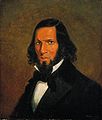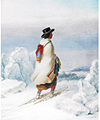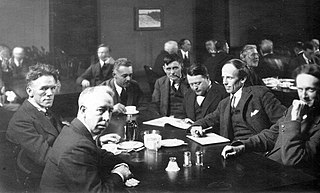
The Group of Seven, once known as the Algonquin School, was a group of Canadian landscape painters from 1920 to 1933, with "a like vision". It originally consisted of Franklin Carmichael (1890–1945), Lawren Harris (1885–1970), A. Y. Jackson (1882–1974), Frank Johnston (1888–1949), Arthur Lismer (1885–1969), J. E. H. MacDonald (1873–1932), and Frederick Varley (1881–1969). A. J. Casson (1898–1992) was invited to join in 1926, Edwin Holgate (1892–1977) became a member in 1930, and Lionel LeMoine FitzGerald (1890–1956) joined in 1932.

Jean-Paul Riopelle, was a Canadian painter and sculptor from Quebec. He had one of the longest and most important international careers of the sixteen signatories of the Refus Global, the 1948 manifesto that announced the Quebecois artistic community's refusal of clericalism and provincialism. He is best known for his abstract painting style, in particular his "mosaic" works of the 1950s when he famously abandoned the paintbrush, using only a palette knife to apply paint to canvas, giving his works a distinctive sculptural quality. He became the first Canadian painter since James Wilson Morrice to attain widespread international recognition and high praise, both during his career and after his death. He was a leading artist of French Lyrical Abstraction.

Kenneth Roy Thomson, 2nd Baron Thomson of Fleet, known in Canada as Ken Thomson, was a Canadian/British businessman and art collector. At the time of his death, he was listed by Forbes as the richest person in Canada and the ninth richest person in the world, with a net worth of approximately US $19.6 billion.
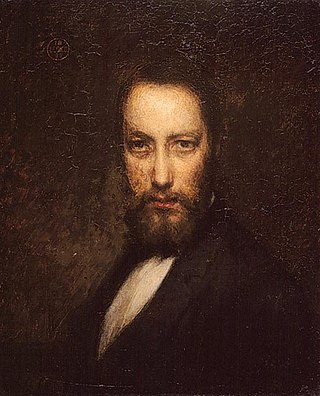
Ozias Leduc is one of Quebec's early painters. He was born in Saint-Hilaire-de-Rouville. Leduc produced many portraits and landscapes.

Frederick Horsman Varley was a member of the Canadian Group of Seven.

Franklin Carmichael was a Canadian artist and member of the Group of Seven. Though he was primarily famous for his use of watercolours, he also used oil paints, charcoal and other media to capture the Ontario landscapes. Besides his work as a painter, he worked as a designer and illustrator, creating promotional brochures, advertisements in newspapers and magazines, and designing books. Near the end of his life, Carmichael taught in the Graphic Design and Commercial Art Department at the Ontario College of Art.
William Raphael, born Israel Rafalsky, was a Prussian-born Canadian painter of portraits, still lifes, genre scenes and landscapes, best known for his lively scenes of the Montreal harbour and market life. He was the first Jewish professional artist to establish himself in Canada, a charter member of Montreal's Society of Canadian Artists in 1868, a member of the Ontario Society of Artists in 1879 and a charter member of the Canadian Academy of Arts in 1880.

Marcel Barbeau, was a Canadian painter, sculptor, graphic and performance artist who used different forms of abstraction and art techniques and technology to express himself.

Wyatt Eaton, baptised Charles Wyatt Eaton, was a Canadian-American portrait and figure painter, remembered as one of the founders of the Society of American Artists.

Frederick Arthur Verner was a Canadian painter, well-known for his paintings of the First Nations in the Canadian west and for his paintings of buffalo. His pictures of the buffalo were thought to be “a class of subject where he stands almost alone and unrivalled,” said Toronto`s The Globe in 1906. Verner set a standard in this department of art, it added in 1908.
J. Russell Harper FRSC was a Canadian art historian and curator who pioneered the field of Canadian art history. As Robert Fulford said in the Toronto Star: "He did more than anyone else to give Canada a sense of its fine-art tradition".

Jack Hamilton Bush was a Canadian abstract painter. A member of Painters Eleven, his paintings are associated with the Color Field movement and Post-painterly Abstraction. Inspired by Henri Matisse and American abstract expressionist painters such as Helen Frankenthaler and Morris Louis, Bush encapsulated joyful yet emotional feelings in his vibrant paintings, comparing them to jazz music. Clement Greenberg described him as a "supreme colorist", along with Kenneth Noland in 1984. Bush explained that capturing the feeling of a subject rather than its likeness was
a hard step for the art loving public to take, not to have the red look like a side of a barn but to let it be the red for its own sake and how it exists in the environment of that canvas.
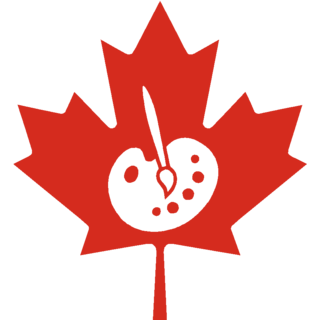
Canadian art refers to the visual as well as plastic arts originating from the geographical area of contemporary Canada. Art in Canada is marked by thousands of years of habitation by Indigenous peoples followed by waves of immigration which included artists of European origins and subsequently by artists with heritage from countries all around the world. The nature of Canadian art reflects these diverse origins, as artists have taken their traditions and adapted these influences to reflect the reality of their lives in Canada.

Clarence Alphonse Gagnon, LL. D. was a French Canadian painter, draughtsman, engraver and illustrator. He is known for his landscape paintings of the Laurentians and the Charlevoix region of eastern Quebec.

Alexan Simeon Janvier was a First Nations painter in Canada. A member of the Indian Group of Seven, he helped pioneer contemporary Aboriginal art in Canada.
Dennis Richard Reid was a Canadian curator and art historian whose exhibitions and catalogues were praised by peers as "impressive" and scholarship "coherent" and "commendable".

RiverBrink Art Museum is located on the Niagara Parkway in the historic village of Queenston, Niagara-on-the-Lake. Open to the public since 1983, the museum is home to a unique collection of over 1,400 works by Canadian and international artists.

Tom Thomson (1877–1917) was a Canadian painter from the beginning of the 20th century. Beginning from humble roots, his development as a career painter was meteoric, only pursuing it seriously in the final years of his life. He became one of the foremost figures in Canadian art, leaving behind around 400 small oil sketches and around fifty larger works on canvas.
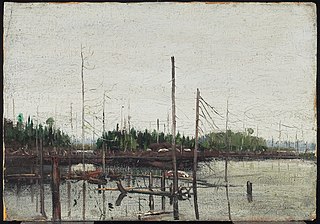
Drowned Land is a 1912 oil sketch by the 20th-century Canadian painter Tom Thomson.
Edward Scrope Shrapnel (1845–1920) was an English-born Canadian artist. After an earlier period spent in Quebec, his family settled in Orillia, Ontario. Having learned the basic art of drawing in the military, Shrapnel became adept in watercolour, his preferred medium. In the 1870s, he began contributing works to the Ontario Society of Artists. He was elected as an associate member of the Royal Canadian Academy in 1880. After a five-year stint as a drawing teacher for a women's college, he moved west to Victoria, British Columbia. Shrapnel was president of Victoria's first art association. His painting subject matter included landscape, still lifes, and genre, often incorporating scenes from Ontario and British Columbia.



